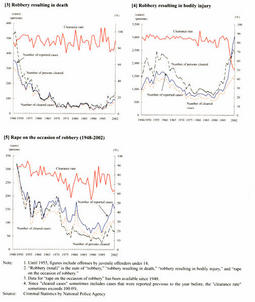| Previous Next Index Image Index Year Selection | |
|
|
In White Papers on Crime, heinous offenses are divided into homicide and robbery, and robbery includes not only robbery under the Penal Code (including constructive robbery) but also robbery resulting in bodily injury, robbery resulting in death (including homicide on the occasion of robbery), and rape on the occasion of robbery (including rape on the occasion of robbery resulting in death). Fig. 5-2-1-1 shows the trends in the number of reported cases, number of cleared cases, number of persons cleared, and clearance rate for homicide and robbery (total) as well as for robbery resulting in bodily injury, robbery resulting in death, and rape on the occasion of robbery over the 57 years from 1946 to 2002.
The number of reported cases of homicide declined gradually after continuing to increase from 1946 to 1954, and it has been on a flat or slightly increasing trend since 1991. The same trend is seen in the number of cleared cases and the number of persons cleared and there is not such a gap between these numbers, suggesting that most homicide offenses have been committed by sole perpetrators (see Chapter 3, Section 2, 2(2) ). The clearance rate for homicide has almost always been at a high level of 94% or over except for the chaotic period immediately after the war. The number of reported cases of robbery (total) surged to about 10,000 during the chaotic period immediately after the war, but continued to decline gradually since then, showing a flat or slightly decreasing trend from 1975 to 1988. However, the number started to increase in 1990, showing a remarkable upward trend since 1996. The number of reported cases increased about 3-fold from 1995 to 2002. Almost the same trend has been seen in the number of cleared cases and the number of persons cleared, but the gap between these two numbers and the number of reported cases has been widening since 1999, suggesting that clearance cannot keep up with such a rapid increase in the number of reported cases. Compared with homicide, the number of persons cleared is relatively larger than the number of cleared cases in the case of robbery, and this tendency indicates that robbery cases include quite a number of accomplice cases (cases involving 2 or more perpetrators) (see Chapter 3, Section 2, 2(2) ). The clearance rate for robbery remained at a high level of around 80% until 1998, but fell below 50% in 2001 due to a drastic increase in the number of reported cases. In 2002, however, the clearance rate surpassed the 50% mark again, showing an upward trend. Robbery resulting in death (including homicide on the occasion of robbery) is an extremely serious offense for which the death penalty or life imprisonment with labor is prescribed as a statutory punishment. The number of reported cases declined rapidly since the chaotic period immediately after the war and had remained almost flat since 1967, but started to increase in 1996. Almost same trend has been seen in the number of cleared cases and the number of persons cleared, but recently, the number of persons cleared has been larger than the number of cleared cases, which indicates that the number of accomplice cases is increasing. The clearance rate for robbery resulting in death fluctuates every year because the number of reported cases is quite small, maintaining a relatively high level at about 80%. Robbery resulting in bodily injury is a considerably serious offense for which life imprisonment with labor or imprisonment for a limited term of not less than 7 years with labor is prescribed as a statutory punishment. The number of reported cases declined gradually after peaking in 1955 and remained almost flat since 1976. However, the number started to increase in 1991, showing a remarkable upward trend since 1996. The number of reported cases increased 3.2-fold from 1995 to 2002. Almost the same trend has been seen in the number of cleared cases and the number of persons cleared, but the number of persons cleared has been significantly larger than the number of cleared cases as in the case of robbery (total), which implies that cases of robbery resulting in bodily injury include quite a number of accomplice cases. The clearance rate for this offense shows almost the same trend as that for robbery (total). Rape on the occasion of robbery is an extremely despicable and malicious offense for which a heavy punishment is prescribed as in the case of robbery resulting in death or bodily injury. The number of reported cases continued to decline after the war but started to increase in 1996. The number of reported cases increased 2.4-fold from 1995 to 2002. Almost the same trends have been seen in the number of cleared cases and the number of persons cleared, but the number of cleared cases has been larger than the number of persons cleared almost every year since 1972. This remarkable trend, which is not seen with respect to other types of robbery, may be due to the fact that many cases of rape on the occasion of robbery have been committed by habitual offenders. The clearance rate for this offense has been fluctuating significantly depending on successful clearance of habitual offenders, maintaining a relatively high level in around a range between 60% and 80%. Fig. 5-2-1-1 Trends in the number of reported cases, number of cleared cases, number of persons cleared, and clearance rate for homicide and robbery (1946-2002) |

